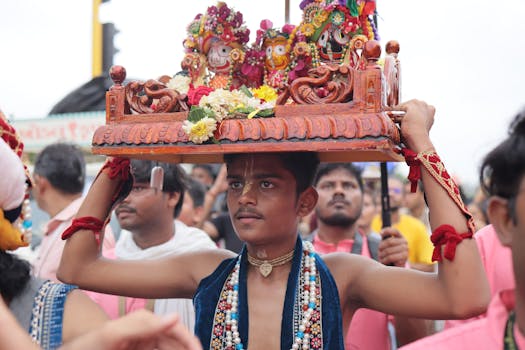
**
Jagannath Rath Yatra 2025: Unveiling the Symbolism and Significance of the Chariots
The vibrant spectacle of the Jagannath Rath Yatra, also known as the Chariot Festival, is a momentous event in the Hindu calendar. Scheduled for 2025, this grand procession promises to once again captivate millions with its divine energy and rich cultural heritage. But beyond the dazzling display of colors, music, and devotees, lies a profound symbolism deeply interwoven into the very fabric of the chariots themselves. This article delves into the significance of these magnificent structures, exploring their intricate details and the spiritual journey they represent.
Understanding the Jagannath Rath Yatra: A Divine Procession
The Jagannath Rath Yatra, primarily celebrated in Puri, Odisha, India, is a unique festival dedicated to Lord Jagannath, his brother Balabhadra, and sister Subhadra. The core of the festival revolves around the annual journey of these deities from their abode in the Jagannath Temple to their aunt's (Gundicha Mata) temple and back. This seemingly simple journey holds immense spiritual meaning, symbolizing the cyclical nature of life, death, and rebirth. The festival attracts countless pilgrims and tourists, making it a significant event for both religious and cultural tourism in India.
The Symbolism of the Chariots: More Than Just Wooden Structures
The chariots themselves are not merely vehicles for transportation; they are powerful symbols carrying deep spiritual and philosophical meaning. Let's explore the key aspects:
The Three Chariots:
Nandighosa (Lord Jagannath): The largest and most majestic chariot, representing the supreme consciousness. Its size signifies the dominance and power of the Lord. The intricate carvings on the chariot often depict scenes from Hindu epics, further enriching its spiritual significance.
Taladhwaja (Lord Balabhadra): The second largest chariot, representing strength, stability, and the protective aspect of the divine. Its design and ornamentation often reflect Balabhadra's steadfast nature.
Darpadalana (Goddess Subhadra): The smallest chariot, symbolizing beauty, grace, and the divine feminine energy. Its delicate design and vibrant colors reflect the gentle and nurturing aspect of the goddess.
The Construction and Materials:
The chariots are traditionally constructed from wood, predominantly neem wood, which is considered sacred. This choice of material reflects the connection to nature and the ephemeral nature of life. The entire construction process is a ritualistic event, involving skilled craftsmen and artisans who pass down their knowledge through generations. The use of specific materials and techniques holds deep symbolic significance.
The Wheels and the Journey:
The massive wheels of the chariots further contribute to the symbolism. The rotation of the wheels represents the ceaseless cycle of time and the continuous journey of the soul towards enlightenment. Pulling the chariots is considered a sacred act, a participation in the divine journey. Millions of devotees actively participate in this, fostering a deep sense of spiritual connection.
The Decor and Ornamentation:
The chariots are intricately decorated with vibrant colors, flowers, and traditional ornaments. This visual splendor reflects the divine glory and enhances the overall festive ambiance. The decorations are not mere embellishments; they represent the divine energy and the spiritual vibrancy of the festival.
Significance of the Rath Yatra: Beyond the Pageantry
The Jagannath Rath Yatra holds immense cultural and religious significance, extending far beyond the visual spectacle:
Moksha (Liberation): The journey is seen as a symbolic representation of the soul's journey towards liberation or moksha. The deities’ movement from the temple to Gundicha temple and back mirrors the soul's journey through life and its eventual return to the divine.
Darshan (Divine Sight): The festival provides devotees with an opportunity to witness the darshan (divine sight) of Lord Jagannath, enhancing their faith and spiritual connection. This direct interaction with the divine is considered a highly auspicious event.
Social Harmony: The festival transcends social boundaries, bringing people together irrespective of caste, creed, or religion. It promotes social harmony and unity in a deeply moving display of collective participation.
Cultural Preservation: The Jagannath Rath Yatra serves as a vital platform for preserving the rich cultural heritage of Odisha. The traditional crafts, music, dance, and rituals associated with the festival are meticulously maintained, ensuring their continuity for generations to come.
Jagannath Rath Yatra 2025: Preparations and Expectations
As 2025 approaches, the preparations for the Jagannath Rath Yatra are already underway. The meticulous construction of the chariots, the sourcing of sacred neem wood, and the organization of the vast logistics involved are all undertaken with unwavering devotion. The festival is anticipated to draw millions of devotees and tourists, creating a unique blend of spiritual fervor and cultural celebration. The Odisha government, along with various organizations, work tirelessly to ensure a smooth and safe pilgrimage for all participants. The increased focus on sustainable practices and crowd management reflects a modern approach to managing this ancient tradition.
Conclusion: A Timeless Journey of Faith and Devotion
The Jagannath Rath Yatra is more than just a festival; it's a deeply spiritual and cultural journey that has captivated hearts and minds for centuries. The symbolism embedded in the chariots, their construction, and the entire procession offers a profound insight into the rich tapestry of Hindu mythology and philosophy. As we look forward to the Jagannath Rath Yatra 2025, let's appreciate the timeless significance of this extraordinary event and the unwavering devotion it inspires. The festival serves as a powerful reminder of the enduring human quest for spiritual enlightenment and the importance of communal harmony and cultural preservation. The upcoming 2025 event is sure to be another unforgettable testament to the enduring power of faith and tradition.


















